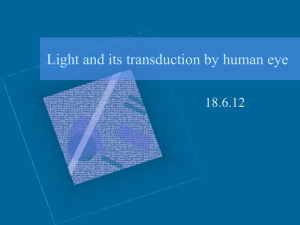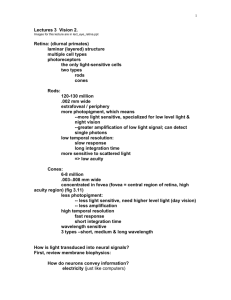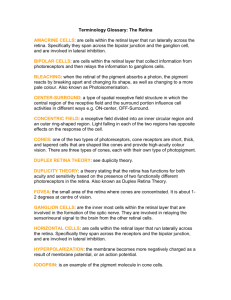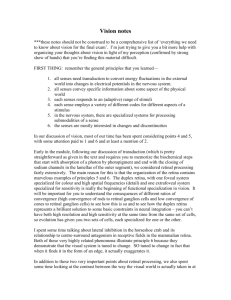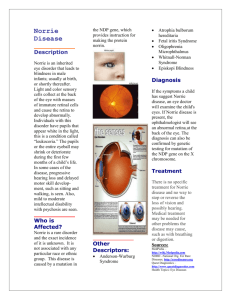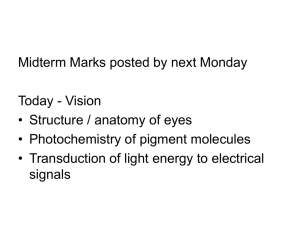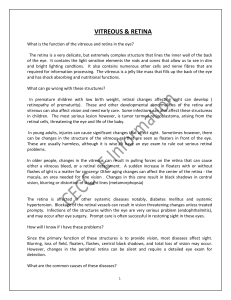Review questions
advertisement
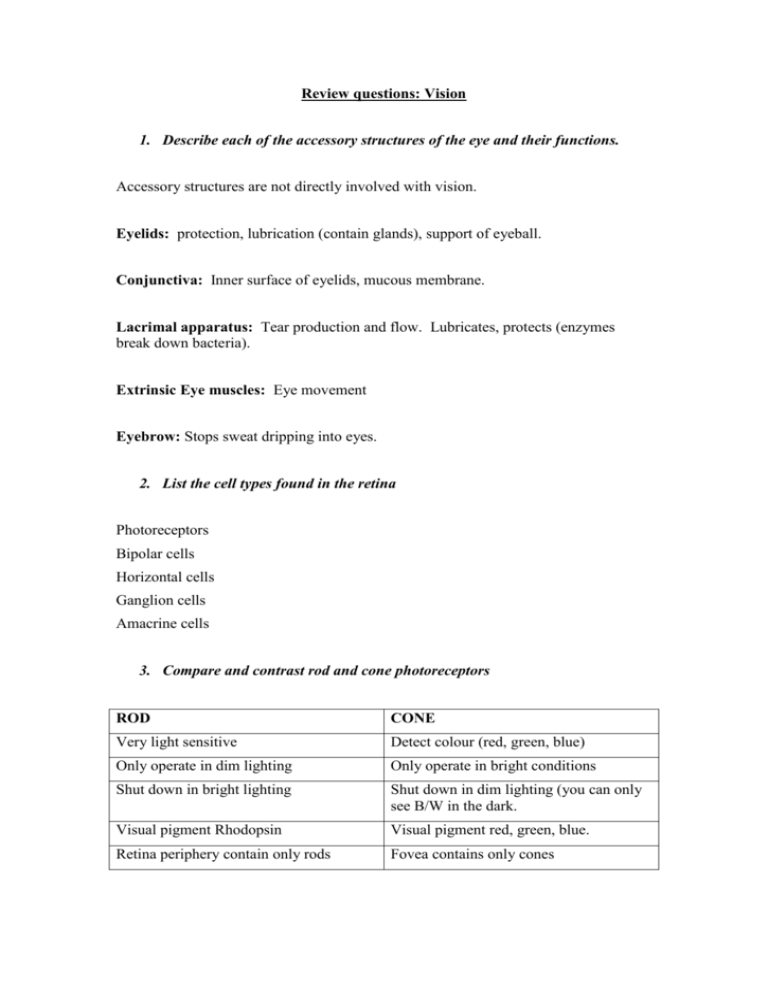
Review questions: Vision 1. Describe each of the accessory structures of the eye and their functions. Accessory structures are not directly involved with vision. Eyelids: protection, lubrication (contain glands), support of eyeball. Conjunctiva: Inner surface of eyelids, mucous membrane. Lacrimal apparatus: Tear production and flow. Lubricates, protects (enzymes break down bacteria). Extrinsic Eye muscles: Eye movement Eyebrow: Stops sweat dripping into eyes. 2. List the cell types found in the retina Photoreceptors Bipolar cells Horizontal cells Ganglion cells Amacrine cells 3. Compare and contrast rod and cone photoreceptors ROD CONE Very light sensitive Detect colour (red, green, blue) Only operate in dim lighting Only operate in bright conditions Shut down in bright lighting Shut down in dim lighting (you can only see B/W in the dark. Visual pigment Rhodopsin Visual pigment red, green, blue. Retina periphery contain only rods Fovea contains only cones Describe the process of phototransduction Light signal electrical impulse Occurs in photoreceptors. Retinal binds with opsin. Begins in 11-cis isomer shape. When struck by light it absorbs photons and changes to all-trans isomer shape. The change in shape causes retinal to detach from opsin. This breakdown is called “bleaching of the pigment”. In the dark, cGMP binds to sodium channels and holds them open. Na+ continually enters the outer segment, producing a dark current that maintains a transmembrane potential of -40mV. This depolarizing current keeps the Ca2+ channels at the photoreceptor synaptic endings open, permitting continuous neurotransmitter (glutamate) release by the photoreceptors at their synapses with the bipolar cells. When light triggers bleaching, Na+ entry is shut off. Enzyme cascade destroys the cGMP that keeps the Na+ gates open in the dark. Freed opsin interacts with transducin, activating it. Transducin, activates PDE, the enzyme which breaks down cGMP. Na+ gates close. No Na+ entering, but K+ still enters, hyperpolarising the receptor to -70mV. Hyperpolarisation inhibits neurotransmitter release. Phototransduction – - The phototransduction cascade is initiated when a photon of light hits a molecule of 11-cis retinal within an opsin protein. This causes photoisomerisation to all-trans retinal. - The opsin proteins are g-protein coupled receptors, which to which 11-cis retinal is an antagonist and all-trans retinal an agonist. The affinity for the cis form is far greater than for the trans form, allowing bleached retinal to dissociate and be regenerated in the pigment epithelium. - The g-protein that interacts with the rhodopsin complex is transducin, which when bound to GTP activates a cGMP phosphodiesterase. This hydrolyses cGMP into GMP. - cGMP (produced constantly via GMP cyclase) is required to keep open the channels through which the dark current flows, and so the end point of the cascade is a reduction in this current. - This in turn leads to a reduction in the release of glutamate from the rod or cone terminal. Note that the terminals are highly adapted for constant, efficient vesicle release, particularly through the presence of synaptic ribbons. - Within the retina, action potentials are only seen in the ganglion cells and some amacrine cells – all other cells use graded potentials. This strategy works because of the small size of these cells. 5. What is the RPE and why is it important for retinal function? Retinal Pigment Epithelium The retinal pigment epithelium (RPE) is a transporting epithelial monolayer that controls hydration and composition of the sub retinal space. Also nourishes photoreceptors. 4. A photon of light is captured by the retina and the information is passed to the visual cortex to become a perceived visual image. Describe all cells and structures this information passes through when it takes the shortest route from photoreceptor to visual cortex Optic nerve Optic chiasm Optic tract Lateral geniculate nucleus (LGN) in thalamus Optic radiations Visual cortex. 5. Define: emmetropia, myopia and hyperopia. Emmetropia refers to a refractive state in which light rays come to a sharp focus on the retina without corrective lenses. Nearsightedness , termed myopia , is a condition where the refractive state of the eye is too strong , and light rays come to a focus in front of the retina . A nearsighted person can see well up close but has difficulty with distance vision . Farsightedness , termed hyperopia , is a condition where the refractive state of the eye is too weak, and light rays come to a focus behind the retina . 8. Why is a dark adapted retina so sensitive to light? Cones shut off in dim conditions and when you move into light they must adjust. Rhodopsin (in rods) is very prone to bleaching. In high intensity light, there will be wholesale bleaching of rhodopsin, rendering the rods inoperable. It may take up to 60 seconds to switch over to cone operation in light and up to 5-10 minutes for complete improvement. Dark adaptation occurs because rod pigments have been bleached out by the light, and it may take time for rhodopsin to accumulate again. 9. What functions do the ciliary body and canal of Schlemm perform? Canal of Schlemm Canal of Schlemm a drainage vessel; provides a route for excess aqueous humour to drain out of the eye; receives aqueous humour from the trabecular meshwork. Ciliary body The muscular and vascular structure that regulates thickness of the lens, secretes aqueous humour, and aids in drainage of aqueous humour

